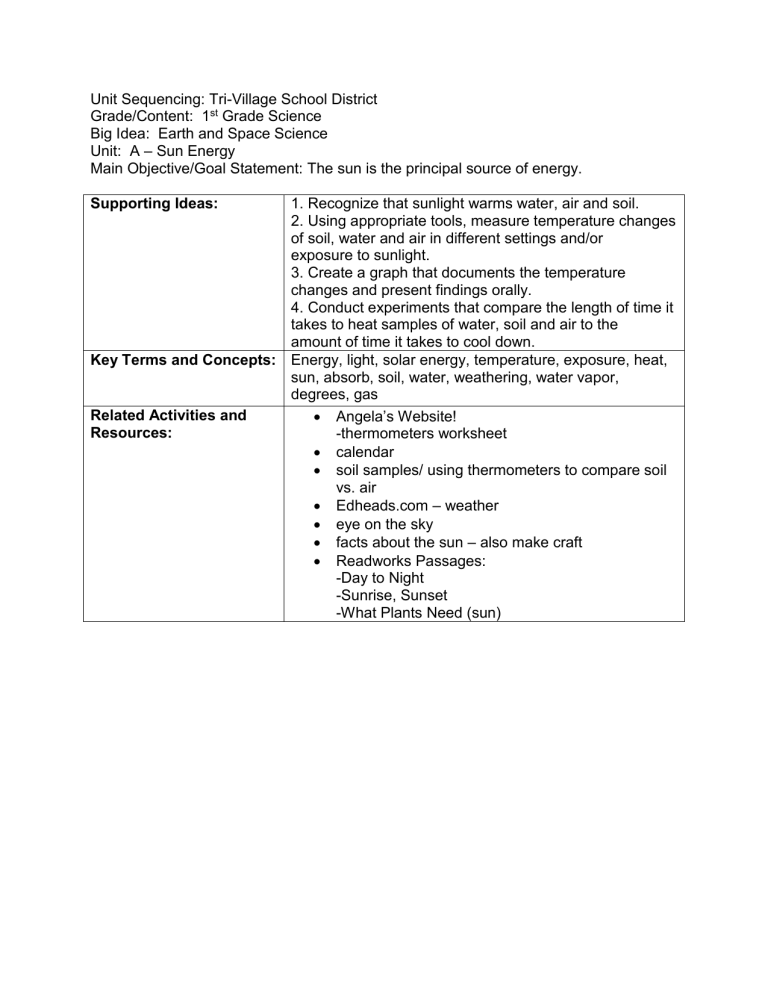Science Unit Plans

Unit Sequencing: Tri-Village School District
Grade/Content: 1 st Grade Science
Big Idea: Earth and Space Science
Unit: A
– Sun Energy
Main Objective/Goal Statement: The sun is the principal source of energy.
Supporting Ideas: 1. Recognize that sunlight warms water, air and soil.
2. Using appropriate tools, measure temperature changes of soil, water and air in different settings and/or exposure to sunlight.
3. Create a graph that documents the temperature changes and present findings orally.
4. Conduct experiments that compare the length of time it takes to heat samples of water, soil and air to the amount of time it takes to cool down.
Key Terms and Concepts: Energy, light, solar energy, temperature, exposure, heat, sun, absorb, soil, water, weathering, water vapor,
Related Activities and
Resources: degrees, gas
Angela’s Website!
-thermometers worksheet
calendar
soil samples/ using thermometers to compare soil vs. air
Edheads.com – weather
eye on the sky
facts about the sun – also make craft
Readworks Passages:
-Day to Night
-Sunrise, Sunset
-What Plants Need (sun)
Unit Sequencing: Tri-Village School District
Grade/Content: 1 st Grade Science
Big Idea: Earth and Space Science
Unit: B
– Water
Main Objective/Goal Statement: The physical properties of water change.
Supporting Ideas:
Key Terms and Concepts:
Related Activities and
Resources:
1. Identify the different areas where water can be observed using personal experiences and maps.
2. Differentiate between fresh and salt water.
3. Recognize that water can be a solid or a liquid.
4. Recall that heating and freezing water changes it from a solid to a liquid or a liquid to a solid.
5. Compare temperature of the outside environment to the type of precipitation observed.
6. Discuss the idea that water can change the shape of the land.
7. Use appropriate tools to test and measure water’s weight, texture, temperature and size to document the physical properties. soil, heat, liquid, solid, gas, physical properties, water, ice, water vapor, precipitation, erosion, fresh water, salt water, ocean, river, stream, pond, temperature, absorb, wetland, heat, weathering, sun, freeze, environment, land, texture, balance scale, weight
Angela’s website!
-bend it, stretch it, squash it
Water cycle song
Edheads.com
– weather
Google: water activities for 1 st grade
Readworks passages
Sink/float in salt/fresh water
Unit Sequencing: Tri-Village School District
Grade/Content: 1 st Grade Science
Big Idea: Life Science
Unit: A
– Basic needs of living things
Main Objective/Goal Statement: Living things have basic needs, which are met by obtaining materials from the physical environment.
Supporting Ideas: 1. Identify the basic survival needs of plants and animals.
2. Discuss how those basic needs are obtained (i.e. plants get energy from the sun, animals consume).
3. Observe a living organism obtaining basic needs in nature (i.e. birds eating at a bird feeder).
Key Terms and Concepts:
Related Activities and
Resources:
Living, non-living, food, shelter, obtain, needs, consume, survival, grow, resources, habitat, organism, adaptation, environment, migration, hibernation
*animal research – butterflies
*animal flip books
*polar bears – blubber (adaptations)
*basic pictures of Ohio animals
*Brown Bear, Brown Bear, What Do You Need?
Unit Sequencing: Tri-Village School District
Grade/Content: 1 st Grade Science
Big Idea: Life Science
Unit: B
– Environment of living things
Main Objective/Goal Statement: Living things survive only in environments that meet their needs.
Supporting Ideas: 1. Match pictures of local plants and animals to the environment in which they can be found.
2. Explain, draw, journal and photograph what happens to a local living environment over the course of the year.
3. Determine the purpose for those basic needs (i.e. grow, shelter, reproduction, etc.)
4. Discuss how the seasonal changes within that local environment directly impact the availability of the resources and the behavior of the living things found there (i.e. migration, hibernation, etc).
5. Compare and contrast how the amount and distribution of resources will directly affect the survival of a living thing.
6. Compare the differences in needs within similar organisms and discuss why those differences exist (i.e.
Key Terms and Concepts:
Related Activities and
Resources: different types of birds eat different things).
Living, non-living, food, shelter, obtain, needs, consume, survival, grow, resources, habitat, organism, adaptation, environment, migration, hibernation
Angela’s website!
animal research – butterflies
habitat flip books
Readworks passages
Weather journals - compare/contrast the same place in the environment several times every month (date, temperature, draw picture, observe/write description, clothes)
Unit Sequencing: Tri-Village School District
Grade/Content: 1 st Grade Science
Big Idea: Physical Science
Unit: A
– Properties of Matter
Main Objective/Goal Statement: Properties of objects and materials can change.
Supporting Ideas:
Key Terms and Concepts:
Related Activities and
Resources:
Recognize and classify various types of changes that objects or materials can go through to change observable properties (i.e. freezing, melting, tearing, burning).
2. Observe that when a liquid turns to a solid or a solid to a liquid, the amount of material remains the same.
3. Conduct experiments to observe what happens to the function of toys when one or more parts are missing.
4. Plan and implement an investigation to determine how shape affects the ability of a material to float or sink in water (i.e. boat building contest).
Properties, freezing, melting, tearing, burning, liquid, solid, gas, material, float, sink
Angela’s website!
states of matter
Readworks passages
Changing properties
– freezing, burning, evaporation, baking (chemical change)
Changing state – melting snow, measure mass, then freeze
Water in different containers, freeze, how long does it take to freeze/melt
Groups develop strategies for melting ice the fastest (The Great Melt Race)
Group molecule simulation
Take toys apart, can you put it back together, can you change it to make it better?
Build model boats, what materials are best for floating?
Send an index card home and ask students/parents to change it somehow and bring it back
Making pudding/watching it change properties
Apple unit!
Sink/float in salt/fresh water
Tearing/crumbling paper for art projects (snowman pictures)
Unit Sequencing: Tri-Village School District
Grade/Content: 1 st Grade Science
Big Idea: Physical Science
Unit: B
– Object Movement
Main Objective/Goal Statement: Objects can be moved in a variety of ways, such as straight, zigzag, circular and back and forth.
Supporting Ideas: 1. Identify an object’s position with respect to another object or the background.
2. Recall that objects can be moved and their positions changed.
3. Recognize that to speed up, slow down or change the movement direction of an object, a push or pull is needed.
4. Investigate ways to make a ball move in a zig-zag pattern by designing a device that will allow it to move in that manner. Present results to the class.
Compare different methods of classmates and redesign the original device.
5. Discuss that changes in motion are a result of changes in energy.
Key Terms and Concepts: Force, motion, push, pull, ramp, material, zigzag,
Related Activities and
Resources: direction, straight, incline, circular, back and forth, position, energy
Angela’s website!
Readworks passages
6 th grade roller coasters
Marble races
How fast/slow does something go based on weight
What kinds of movement happens on different playground equipment
Olympics
– what motion/movement does each event require
Scooters – push/pull
Depth perception pictures (horizon, stand down the hallway and measure another persons’ height between your fingers)





